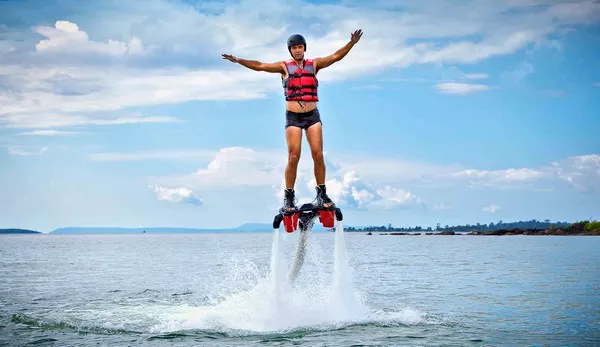Flyboarding, a thrilling watersport that combines elements of jetpacks and wakeboarding, has gained popularity among adventure enthusiasts worldwide. This exhilarating activity allows participants to soar above the water’s surface, performing incredible aerial maneuvers. If you’re eager to learn how to flyboard and experience the adrenaline rush firsthand, this comprehensive guide will provide you with everything you need to know to get started and master this exciting sport.
Understanding the Basics
Before diving into the practical aspects of flyboarding, it’s essential to grasp the fundamental concepts and equipment involved:
1. Flyboard Equipment:
- The flyboard itself consists of a board resembling a wakeboard, which is attached to a long hose connected to a personal watercraft (PWC) such as a jet ski.
- The PWC generates water pressure, which is redirected through the hose and expelled from nozzles beneath the flyboard, propelling the rider upwards.
2. Safety Gear:
- Always prioritize safety by wearing a US Coast Guard-approved personal flotation device (PFD) and a helmet.
- Consider using wetsuits or rash guards to protect against water impact and sun exposure.
3. Control Mechanism:
- Flyboarding requires balance and coordination. Tilting your feet forward controls propulsion and lift, while shifting weight from side to side enables directional movement.
Preparing for Your First Flight
Now that you’re acquainted with the basics, it’s time to prepare for your inaugural flyboarding session:
1. Choose a Certified Instructor:
- Locate a reputable flyboarding operator with certified instructors who prioritize safety and provide proper training.
- Instructors will guide you through equipment setup, safety protocols, and flight techniques.
2. Mastering the Balancing Act:
- Begin in shallow waters, gradually acclimating to the equipment and sensation of lift.
- Focus on maintaining a centered stance with knees slightly bent to absorb shock and maintain stability.
3. Understanding Hand Signals:
- Establish clear communication with your instructor using pre-defined hand signals.
- Signals typically include gestures for ‘up,’ ‘down,’ ‘left,’ and ‘right,’ facilitating real-time guidance during your flight.
Taking Flight: Learning the Ropes
With the groundwork laid, it’s time to take flight and experience the thrill of hovering above the water’s surface:
1. Initiating Lift:
- Start in a prone position with the board parallel to the water’s surface.
- Gradually apply pressure to your toes to engage the nozzles and initiate lift.
2. Maintaining Control:
- Once airborne, focus on balance and weight distribution.
- Refrain from making sudden movements; instead, use subtle shifts in posture to adjust direction.
3. Exploring Maneuvers:
- As you gain confidence, experiment with basic maneuvers like turns and gentle descents.
- Practice controlling altitude by adjusting foot pressure to increase or decrease propulsion.
Advanced Techniques and Tricks
As your proficiency improves, challenge yourself with advanced techniques and aerial stunts:
1. Backflips and Spins:
- Mastering rotational movements requires precise weight shifts and coordinated timing.
- Start with small rotations before progressing to full spins and flips.
2. Dolphin Dives:
- Gradually descend towards the water’s surface, mimicking the graceful dive of a dolphin.
- Maintain control to avoid plunging too deep or losing balance upon re-emergence.
3. Incorporating Grab Tricks:
- Once comfortable with flight control, experiment with grabbing the board during mid-air maneuvers.
- Begin with simple grabs before progressing to more complex variations.
Safety Tips and Precautions
While flyboarding offers an unparalleled adrenaline rush, safety should always remain paramount:
1. Regular Equipment Checks:
- Inspect all gear before each session, paying particular attention to hose connections and board integrity.
- Address any issues promptly to mitigate potential risks.
2. Weather Awareness:
- Avoid flyboarding in adverse weather conditions, including strong winds or thunderstorms.
- Be mindful of water currents and potential obstacles beneath the surface.
3. Know Your Limits:
- Progress at your own pace, gradually increasing the complexity of maneuvers as proficiency develops.
- Never attempt advanced tricks without adequate training and supervision.
Conclusion
Flyboarding represents a thrilling fusion of technology and adventure, offering participants a unique perspective on aquatic sports. By familiarizing yourself with the equipment, safety protocols, and fundamental techniques outlined in this guide, you’ll be well-equipped to embark on your flyboarding journey with confidence.
Remember, mastering flyboarding requires patience, practice, and a willingness to push personal boundaries. Embrace the challenge, enjoy the exhilaration of flight, and always prioritize safety to ensure an unforgettable experience on the water. Flyboarding isn’t merely a sport—it’s a gateway to boundless excitement and aerial exploration.

